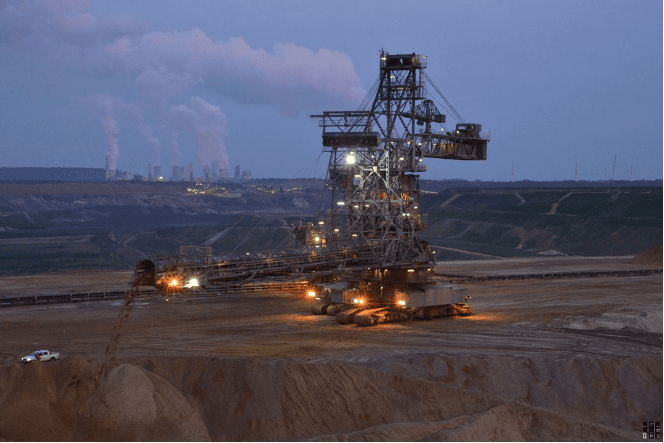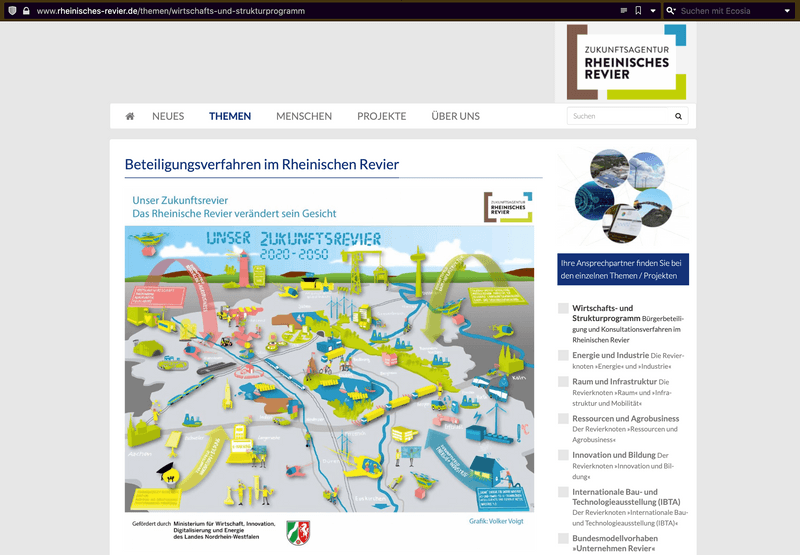31. March 2021The Future Has Just Begun – A Short Profile of the Rhenish Lignite Area
This short overview provides background information on the German coal phase out process, portrays the Rhenish lignite area and describes the main actors and stakeholders active in the region. The regional transition process structure and an update on recent developments complete this regional profile.
Overview
With almost 5,000 square kilometres covering a seventh of the surface of North Rhine-Westphalia and 2.5 million inhabitants, the Rhenish lignite area is one of 100 coal regions worldwide and of 40 in the EU.
The core of the mining activities in the area is located in two districts: Rhein-Erft-Kreis, and Rhein-Kreis-Neuss. In these two districts, lignite mining and power generation accounted for the highest percentages of gross value added, at 13% and 11% respectively. By contrast, in the entire Rhineland lignite region, the relative economic significance of lignite is rather low. Mining and power generation only contribute 0.6% to value creation and directly employ less than 10,000 people or roughly 0.3% of the entire working population.
The area has a highly diversified economic structure, but many of the other industries are highly carbon-intensive and/or fossil fuel dependent as well. Directly dependent on the lignite-based electricity infrastructure are, for example, aluminium smelters and the local pulp and paper industry. Moreover, within the NUTS 2 region, a considerable petro-chemical industry exists with several petroleum refineries and large production plants for chemical raw materials as well as a major production plant of the Ford Motor Company and other automotive suppliers.
In total, more than 90,000 people are employed in energy-intensive industries. The Rhenish area, being embedded in between the urban centres of Cologne, Düsseldorf and Aachen, offers access to jobs in the service industry as well as to higher education opportunities.

Figure 1: Nightshift at Garzweiler open cast lignite mine. Photo: “Night shift just started“ by unefunge on Flickr / CC BY-NC ND 2.0
Background – major building blocks of Germany’s coal phase out
In 2018, the German government had decided to outsource the politically challenging debate on a phase-out of coal production and consumption and mandated an independent expert commission (Commission “Growth, Structural Change and Employment”) to develop a plan to end coal usage and support structural adjustments in the affected regions. This “coal commission” presented its final report in January 2019. It recommended:
- in the short term, to reduce lignite power plant capacity by 5 GW compared to 2017 levels by 2022,
- to continuously reduce coal capacity further to a maximum of 9 GW in 2030 (i.e. 10.9G W below 2017 levels)
- and to altogether phase out coal by 2038 with an option to bring forward the end of coal to 2035
Over the course of 2020, the German Government adopted two major legislative acts that govern the coal transition: the coal phase-out law as well as a structural development act. Both laws are conditional on each other, financial support for the regions is tied to progressing phase-out of coal production and consumption in the region.
The Act on the Phase‐out of Coal‐fired Power Plants combines regulations for the reduction and termination of hard coal and lignite-based electricity generation with a decommissioning path for lignite-based electricity generation, a regulation on compensation as well as further regulations. To ensure that the coal exit also has a positive effect at the European level, the Coal Phase-out Act includes a provision that makes it possible to retire excess CO2 certificates within the European Emissions Trading system. In addition, the extension and further development of the Combined Heat and Power Act will provide power plant operators with incentives to convert from coal to flexible and more climate-friendly electricity generation.
The structural policy recommendations of the Commission “Growth, Structural Change and Employment” will be implemented with the Structural Strengthening Act for Coal Regions. The law was passed by the Bundestag and Bundesrat on 3 July 2020 and entered into force on 14 August 2020. In order to support and shape the structural change in the regions affected by the coal phase-out, the Structural Strengthening Act provides for financial support of up to €40 billion for all German coal regions. The state government of North Rhine-Westphalia will receive €5.18 billion to directly invest in programmes compensating for the loss of jobs and developing a more sustainable economic development pathways in the area. Moreover, the federal government will spend €9.62 billion in the region on infrastructure as well as research and education facilities.
The main actors in the Rhenish region
Against this background, the Rhenish lignite region itself had started activities as early as 2014 in order to prepare and design the structural change process, envisaging an end of the lignite ecosystem in 2050. The main actors and stakeholders are
- at the national level, the Federal Ministry for Economic Affairs and Energy (BMWi)
- at federal state level, the Ministry for Economy, Innovation, Digitalisation and Energy of the state NRW (MWIDE)
- at the regional level, it is the regional development agency “Zukunftsagentur Rheinisches Revier” with several teams of experts lead by external specialists
- at the local level, 20 municipalities of the core region, villages and towns near the open mines and other units of the lignite industry joined forces in a coalition of neighbouring communities
- Several civil society groups are active in the region, among them https://www.unser-revier-unsere-zukunft.de, https://www.buirerfuerbuir.de, and https://www.mik‐zentrum.de

Figure 2: Website of the regional development agency
Regional Process Structure
The federal government and the government of North Rhine Westphalia (NRW) in which the Rhenish area is located developed a process structure together with the regional authorities and economic entities, as the Rhineland is going to be first in starting the coal phase out in Germany.
The change process is structured in activities on several levels being developed in parallel with each other from different hierarchic ranks:
- Legislation, focusing on support mechanisms, at the federal and the federal state level
- Strategy and agreements, focusing on developing solutions to be supported financially, at the state’s and the regional level
- Projects, focusing on ready-to-implement and relevant concepts, at the federal, the state’s as well as the regional level
Recent developments on the legislative level include the frame directive on the federal state level of North-Rhine Westphalia for the execution of the investment law, which has entered force on December 8th, 2020. It can be downloaded here.
On the strategy side, the coal transition in North Rhine-Westphalia is based on a roadbook, which was developed in late 2019 with the aim to give the economic transformation process a goal, a strategy and thus a direction. Hundreds of people from the Rhenish area were involved in the development of this economic and structural programme through expert conferences and workshops. The programme is based on four areas of development (“Zukunftsfelder”):
- Energy and Industry
- Resources and agribusiness
- Innovation and education
- Spatial planning and infrastructure
The programme is currently in the process of further development. It will be discussed in a broad-based participation process with all relevant stakeholders in the Rhenish area.
The development of projects and concrete support measures has been kick-started early on with two federal programmes – Bundesmodellvorhaben “Unternehmen Revier” (2017) and STARK (2020). The former has selected the first 30 projects for funding allocating a total of €3.4 million. The STARK funding programme aims to support the transformation process in coal regions by providing grants for non-investment projects to strengthen structures.
The bulk of the activities, however, will be selected at the regional level under the auspices of the regional development agency (Zukunftsagentur). All major stakeholders are represented in Zukunftsagentur’s supervisory board including state level governments, district governments, the main utility (RWE), local chambers of commerce, industry and crafts, trade unions, counties and major municipalities, as well the core municipalities in which mining activities are located. Together these actors decide on the funding in two major structural change investment programmes. The programming and funding decisions of the projects are progressing and the first projects have been selected in a tiered pre-qualification process. A key challenge for them is to develop key performance indicators to evaluate (and guide) the allocation of structural funds in the region.
Authors
Marie-Luise Schaller
Regional Development Agency “Zukunftsagentur Rheinisches Revier”
Christof Arens
Wuppertal Institute for Climate, Environment and Energy